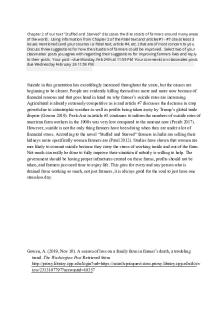ASTR 1010 2020S1 Assignment 1 PDF

| Title | ASTR 1010 2020S1 Assignment 1 |
|---|---|
| Author | Joe Montana |
| Course | Astronomy |
| Institution | Macquarie University |
| Pages | 4 |
| File Size | 143.3 KB |
| File Type | |
| Total Downloads | 5 |
| Total Views | 154 |
Summary
assignment...
Description
ASTR1010 – Assignment 1 Due: 11 PM Friday 17th April 2020 Please read these instructions carefully. This assignment consists of 10 short answer questions (5 marks each). Questions requiring explanations should use around 3-6 sentences and may use diagrams if helpful. Diagrams may be copied directly from the internet, but if you do this you must credit your source (or risk being marked down), and you will get no credit unless you explain the diagram in your own words. Diagrams are the only thing you may directly copy! Everything else must be your own. Other than directly copied diagrams, referencing your sources is not required. Aim to be be concise and to the point – words are not a substitute for understanding. Your completed assignment should be typed (diagrams and labels may be handwritten) and uploaded as a single pdf file via the submission link on iLearn.
Note that Questions 1) and 4) involve online Adobe Flash animations, which you may need to enable or install on your computer. If you need to install Flash, you can download it from: https://get.adobe.com/flashplayer/ If you have just installed Flash, you may need to restart your browser. Whether or not you have just installed Flash, you may also need to enable Flash on your browser for these web pages – for further information, see: Chrome: https://support.google.com/chrome/answer/6258784 Safari: https://helpx.adobe.com/au/flash-player/kb/enabling-flash-player-safari.html If you are still unable to get the online tools working for Q1 and Q4 on you own device, please try a friend's computer. Failing that, please attempt the questions to the best of your ability without viewing the online tools / images, and note in your answers that this is what you did. We will take this into account when marking. Please also note that all questions can be answered correctly with a little bit of thought and/or Googling. Now on to the questions -
1. Visit the Rotating Sky Explorer at: http://astro.unl.edu/naap/motion2/animations/ce hc.html Set the observer’s latitude and longitude to the correct values for Sydney. Set the Star Controls tab to display the constellations of Orion and the Southern Cross. Switch on as many display settings as you like (I recommend checking all the boxes first and later removing ones that are less useful). (a) Which of the two constellations you have displayed is circumpolar from Sydney? (b) What is the meaning of the line that runs through the constellation of Orion? (c) Are there any places on Earth where Orion will be a circumpolar constellation? (d) How does the sky appear to rotate if you move the observer to the North Pole? (e) How does the sky appear to rotate if you move the observer to the Equator?
2. Describe why we are able to see 59% of the Moon’s surface from Earth.
3. Two bodies are orbiting each other in a binary system. Draw a plausible sketch of the orbits inthe two cases given below, being sure to mark on the orbital path of each body and the centre of mass of the system. (a) The two bodies are stars are of equal mass. (b) One body is a Sun-like star and one is a small rocky planet.
4. Visit the Doppler Shift Demonstrator at http://astro.unl.edu/classaction/animations/light/dopplershift.html Set the source to emit radiation. (a) Move the source towards the observer. What happens to the wavelength of the observedradiation? (b) Now move the source away from the observer. What happens to the wavelength of theobserved radiation? (c) What happens if the source is moving purely tangentially to the observer (i.e. neithertowards or away)? (d) From this answer the following: The doppler shifting of radiation from astronomicalobjects allows us to measure which component of their velocity? i. Radial (towards/away from us) ii. Tangential (along side us; neither towards or away) (e) The Hydrogen alpha spectral line is measured experimentally in the lab to have a wavelength of 656.28 nm. Observed from a distant emission nebula it is seen to have a wavelength of 656.58 nm. State whether the line has been redshifted or blueshifted, and what this enables us to tell about the motion of the nebula relative to the Solar System.
5. Look up the following telescopes online: (a) The Atacama Large Millimeter Array (b) The Chandra X-Ray Observatory (c) The Spitzer Space Telescope Pick one and write a few sentences about it, making sure to include what part(s) of the electromagnetic spectrum it can observe. Describe one type of astronomical object that this telescope is well-suited to observe, justifying your answer in terms of the type of radiation they emit and, if relevant, the resolving power of the telescope.
6. Describe how the Sun generates energy. Why can this process only occur in the Sun’s core?
7. Why are parallax measurements only possible for relatively nearby stars? If we set up a colony on Mars and measured parallax from there, would we be able to measure the distances to more or fewer stars (and why)?
8. Explain why emission nebulae are signposts of recent and/or ongoing star formation. 9. Challenge question! The figure below shows two snapshots of supercomputer models of molecular cloud collapse (credit: https://www.astro.ex.ac.uk/people/mbate/):
In these images, the white dots are newly-formed stars, and the red/orange stuff is the gas of the molecular cloud. The two snapshots were both taken at the same time (∼89,000 years after the model started), and the simulations were identical except for one thing: the “stars” formed in the left-hand model were just treated as inert blobs of gas, whereas the stars on the right hand model emit radiation (as real stars do!). A quick glance will tell you that the model on the left has formed many more stars in the same time period. (Count the dots!) With reference to what we have learned about the factors that oppose molecular cloud collapse, why do you think this might be?
10. Finally... Visit http://apod.nasa.gov and use the search function to find a picture related to something we have covered in the course so far (if we haven’t done it in the course you won’t get the marks!) Provide the image and a three-sentence caption condensed from the description available on the page....
Similar Free PDFs

ASTR 1010 2020S1 Assignment 1
- 4 Pages

FINAL EXAM DEMO2002 2020S1
- 3 Pages

100 Conceptos Astr - Apuntes 1
- 102 Pages

Huma 1010 - huma 1
- 2 Pages

MATH 1010 Note 1-Sequences
- 79 Pages

PHIL 120 001 2020S1 - Syllabus
- 6 Pages

COS10011 A1 2020S1 - asdasd
- 8 Pages

ASTR 311 - Reading Notes
- 97 Pages

AG 1010
- 2 Pages

BUSN 1010 Exam Review 1
- 4 Pages

Huma 1010 tarea 1 - asig
- 2 Pages

ASTR 100 3rd midterm homework
- 5 Pages

Astr 207 final spring 2019
- 3 Pages

ASTR 100 Spring 2021 Syllabus
- 6 Pages

Astr 207 final spring 2019
- 4 Pages
Popular Institutions
- Tinajero National High School - Annex
- Politeknik Caltex Riau
- Yokohama City University
- SGT University
- University of Al-Qadisiyah
- Divine Word College of Vigan
- Techniek College Rotterdam
- Universidade de Santiago
- Universiti Teknologi MARA Cawangan Johor Kampus Pasir Gudang
- Poltekkes Kemenkes Yogyakarta
- Baguio City National High School
- Colegio san marcos
- preparatoria uno
- Centro de Bachillerato Tecnológico Industrial y de Servicios No. 107
- Dalian Maritime University
- Quang Trung Secondary School
- Colegio Tecnológico en Informática
- Corporación Regional de Educación Superior
- Grupo CEDVA
- Dar Al Uloom University
- Centro de Estudios Preuniversitarios de la Universidad Nacional de Ingeniería
- 上智大学
- Aakash International School, Nuna Majara
- San Felipe Neri Catholic School
- Kang Chiao International School - New Taipei City
- Misamis Occidental National High School
- Institución Educativa Escuela Normal Juan Ladrilleros
- Kolehiyo ng Pantukan
- Batanes State College
- Instituto Continental
- Sekolah Menengah Kejuruan Kesehatan Kaltara (Tarakan)
- Colegio de La Inmaculada Concepcion - Cebu
